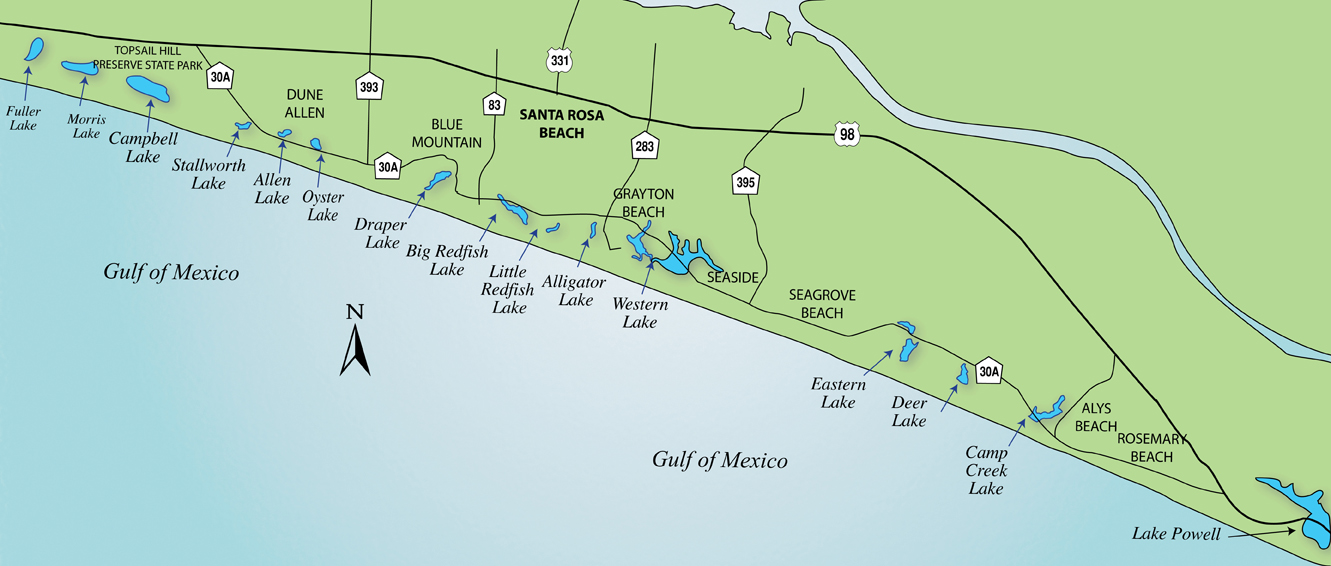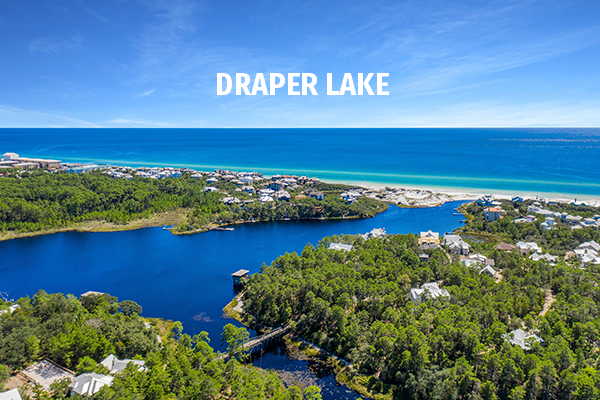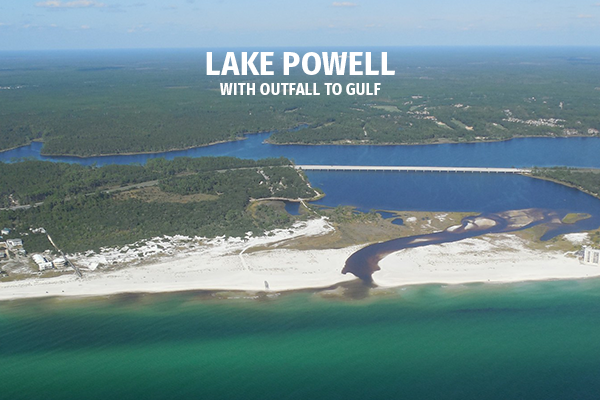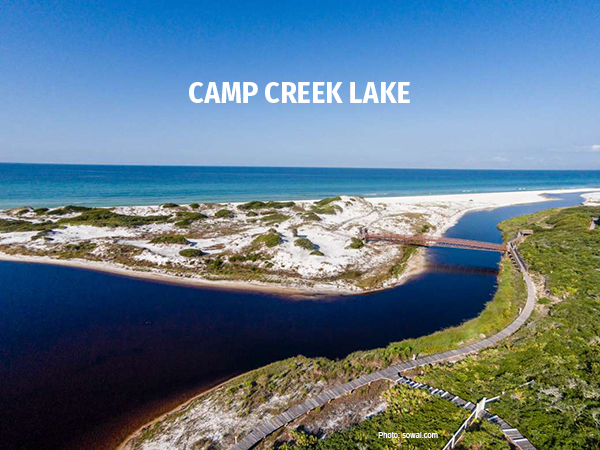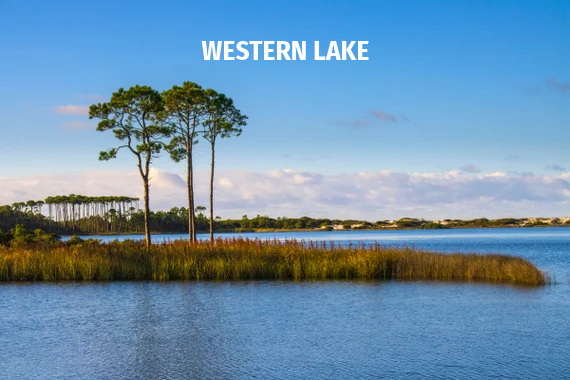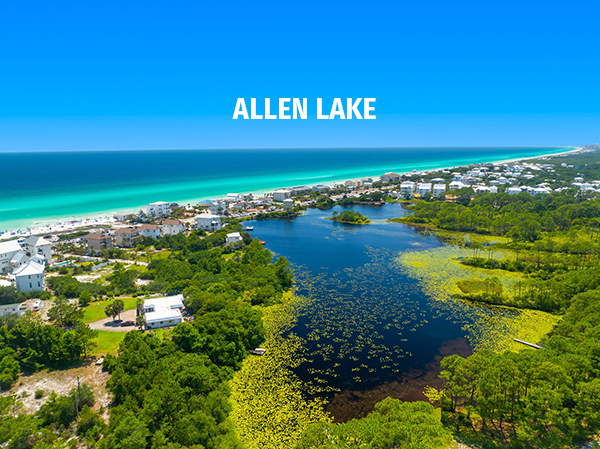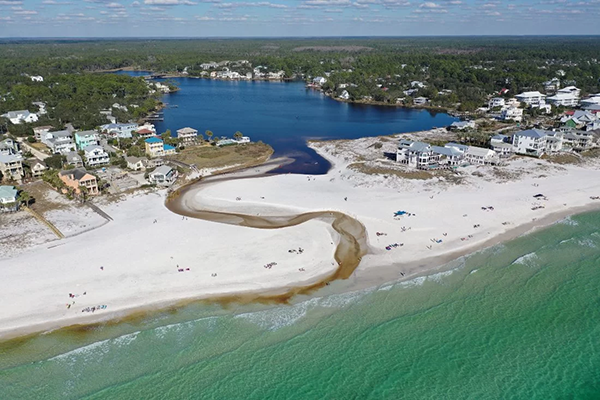Walton County, Florida is home to many state parks, state forests, gorgeous beaches, and also fifteen unique coastal dune lakes that are rare occurrences in our planet’s natural landscape. Coastal dune lakes are found within two miles of the coast and only occur in five places on the globe: Oregon, Madagascar, Australia, New Zealand, and the Florida Panhandle along Scenic 30A.
Meet the Fifteen Coastal Dune Lakes of 30A
These lakes are believed to have formed around 10,000 years ago. The freshwater of the lakes mixes with the saltwater of the gulf in the outfall to create brackish water.
What is brackish water? Brackish water is water that is saltier than fresh water but not as salty as seawater. It can be found in places where fresh and salt water mix, like the dune lakes. Brackish water is safe to swim in but not safe to drink. The 30A coastal dune lakes provide great outdoor recreational areas of serene water and expansive wildlife.
At certain times of the year, the water in the dune lakes looks dark and has tea-stained hues, however, it is not pollution. The color is simply the result of natural tannins that come from leaves, pine straw, and other vegetation that grows around the lakes being absorbed into the water. Locals refer to this color as pine straw tea, but if you look closely, the water is naturally clear.
Streams, groundwater seepage, and rain are the sources that feed the coastal dune lakes. Storm surge creates intermittent connections to the Gulf of Mexico, called outfalls. This periodic connection empties lake water into the Gulf, and, depending on tides and weather, salt water and organisms from the Gulf flow back into the lakes. Outfalls vary in length, frequency and duration.
Facts About Fishing and Watercraft in the Coastal Dune Lakes of 30A
There are 15 different dune lakes along Scenic Highway 30A. Each has its unique ecological structure offering chances for fishing, paddling, hiking, wildlife watching, and more. The dune lakes dot the coast of Scenic Highway 30A and some are located within the Florida State Parks found in the same areas. There are also private homes built near some of the dune lakes, but development is kept to a minimum so as not to upset the natural state of these rare beauties.
A Florida fishing license is required to fish on the coastal dune lakes. It is recommended purchasing a combo fresh/saltwater fishing license issued by the Florida Fish and Wildlife Conservation Commission (FWC). To buy licenses online, click here.
Walton County does not allow jet propelled watercraft such as jet skis on any coastal dune lake. However, Lake Powell, which is primarily located in Bay County does. All lakes allow motorized boats except Topsail Hill Preserve, which does not allow any type of boat, kayak or canoe except on Campbell Lake. However, most of the dune lakes are far too shallow for anything more than a paddleboard or canoe. Click here for a downloadable guide to the lakes.
30A Florida’s Coastal Dune Lakes from West to East
Lake Powell
Lake Powell is the largest coastal dune lake in Florida extending between southwestern Bay County and southeastern Walton County. It is also the deepest of the dune lakes, and you can see people enjoying time in small boats and watercraft in the waters year round.
With over 800 acres, this lake is nourished by freshwater drainage and the connected Gulf of Mexico outfall channel. Its brackish ecosystem allows fresh and saltwater marine and aquatic wildlife to flourish. This is a great place for bird-watching and combining freshwater and saltwater fishing.
A portion of Lake Powell can be accessed within Camp Helen State Park. In the park, from March through September, kayaks and paddle boards are available for park visitors to rent. You can also bring your equipment and launch from Camp Helen at no additional charge. Visitors can enjoy picnicking, fishing, and hiking at the park along the lake. The Park also offers interpretative programs such as ranger-guided moonlight paddling trips that emphasize the importance of the Coastal Dune Lakes and the need to protect its fragile ecosystem.
Camp Creek Lake
This lake is located just off Seacrest Beach and extends to the southeastern edge of Deer Lake State Park. This lake provides 70 acres of serene water and wildlife to explore. This is a great place to kayak, paddleboard, picnic, and fish. The lake offers a variety of fish species including bass, trout, and flounder. If you would like to enjoy a swim you can head over to the banks near the tidal creek where you will find crystal clear water free of debris and plants. Public Access is available along Camp Creek Road North with parking allowed along the county easement per the signage.
Deer Lake
Deer Lake can be accessed from Deer Lake State Park. The ecosystem created by this meshing of freshwater and saltwater provides a fabulous environment. Nature lovers can enjoy the southern magnolias and scrub oaks in this coastal dune habitat. Visitors may see splashes of color from summer wildflowers or many species of resident migratory birds and butterflies. Hikers can enjoy a half-mile lake trail with a scenic overlook of Deer Lake.
Eastern Lake
In Seagrove Beach, you will find a great spot to launch a small boat, kayak, or paddleboard at the public boat ramp on Lakewood Drive. Eastern Lake is the most developed lake in the area with several private homes and condos along the shores. About 66 acres of shallow warmer waters encompass this lake. Paved pathways around the lake allow visitors to explore on foot as well. There is lakeside dining nearby at Old Florida Fish House.
Western Lake
Western Lake is the second largest coastal dune lake stretching between Grayton Beach and the Watercolor community on 30A. This unique, shallow lake with its tall, slash pines on the horizon is one of the most photographed and painted nature scenes by local artists on 30A. Western Lake includes extensive marsh and connected wetlands. Grayton Beach State Park surrounds Western Lake with a boat ramp offering a launch point, canoe, and kayak rentals. Within the park, there are trails along the lake, picnic shelters, and abundant wildlife.
Alligator Lake
Visitors can enjoy 12 acres of underdeveloped natural beauty on this canoe-friendly lake. Visitors may enjoy fishing in Alligator Lake. Alligator Lake is on the western edge of Grayton Beach bordered by the neighborhood of Gulf Trace and Grayton Beach State Park. Visitors may experience sightings of some of the region's wildlife, including the various sea turtles, tortoises, shorebirds, bears, and alligators.
Little Redfish Lake and Big Redfish Lake
Little Redfish Lake is in Blue Mountain Beach on approximately ten acres. Big Redfish Lake is twice the size at 22 acres and stretches across Scenic 30A from Redfish Village Development to the Gulf in the Old Blue Mountain Subdivision. These secluded lakes are great for fishing. These lakes are named for the local redfish that swim in the water.
Draper Lake
Draper Lake can be seen from Scenic 30A with a distinctive covered bridge on the bike path adjacent to the lake. This 28-acre private access lake borders the Gulf of Mexico and the conservation preserve allowing it peace and privacy.
Oyster Lake
This coastal dune lake’s name is inspired by the oyster shell shape of its shore. Located on the west end of Scenic 30A and encompassing 22 acres, this is a perfect place to explore or relax. You can enjoy a stroll along the pedestrian bridge that runs across the length of the water. Visitors can also make the most of the extensive bike path around the lake which is great for cyclists, runners, and walkers.
Allen Lake
Allen Lake includes 22 acres on the north side of scenic 30A. Nature enthusiasts will appreciate the opportunity to explore the nearby Topsail Hill Preserve State Park, which offers hiking trails through dunes and pine forests, as well as bird-watching and wildlife viewing. Popular local eaterie Stinky's Fish Camp sits on the western edge with lakeside dining and a large dock.
Stallworth Lake
Stallworth Lake is partially within Topsail Hill Preserve State Park. Canoes and paddle boards line the shores of this coastal dune lake. Locals rave about the quiet nature scenery of Stallworth Lake. This secluded lake has limited parking at the access within the State Park so you may want to plan early.
Campbell Lake
Campbell Lake is one of the most pristine coastal dune lakes in South Walton County. The lake is inside Topsail Preserve State Park and closest to the park entrance. Visitors can explore the lake by kayak or paddleboard. There are several nature trails to capture views of the coastal dune lake.
Morris Lake
Morris Lake is located at the western end of Topsail Hill State Park. This coastal dune lake is private and mostly untouched. The lake is accessible to the public by a long nature trail. They do not permit any private boat vessels on the lake currently.
Fuller Lake
Fuller Lake is located inside Coffeen Nature Preserve. Visitors will need to make an appointment to the private preserve for access. There is no public access except by reserved tours. To make a reservation call 850-622-3700.
Visit the Rare Coastal Dune Lakes of 30A
Coastal dune lakes are rare occurrences and a natural phenomenon. Dune lakes only occur in a few places across the globe, and citizens of Walton county are proud of conservation efforts to preserve their fifteen lakes. The mix of freshwater and saltwater species in this brackish water makes for an incredibly unique ecosystem and provides for fabulous recreational activities such as wildlife exploring, paddling, and boating. Each of the 15 coastal dune lakes has something to offer visitors. You can experience and explore these treasures for yourself on your next visit to the beaches of 30A.

